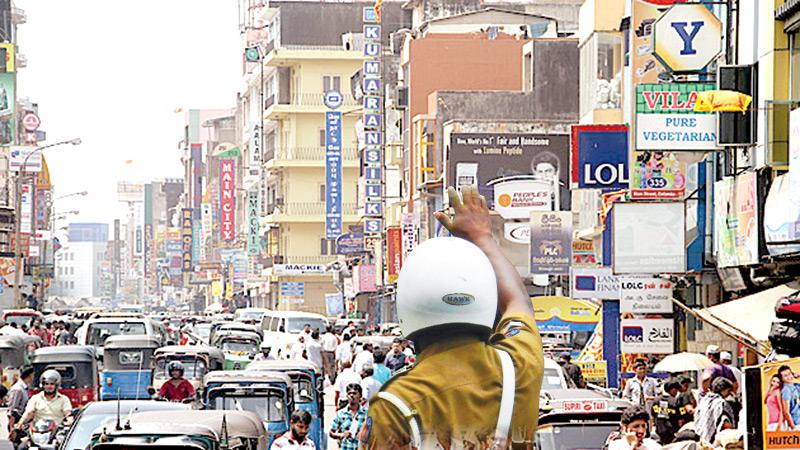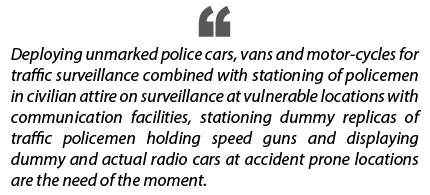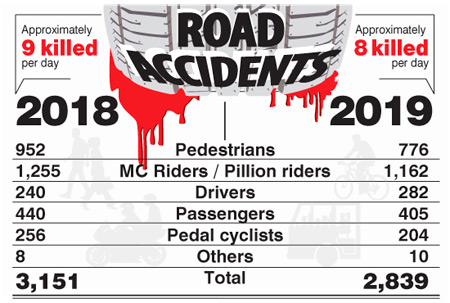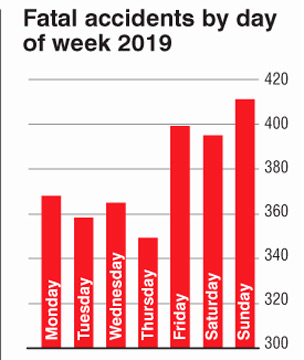
- With one person dying of a road accident every three-and-a-half hours and double that number being maimed for life, road safety needs to be a paramount concern and included in state policy this decade, says former Traffic Administration and Road Safety Head, Rtd DIG, Camillus R. Abeygoonewardena.
- Last Year, daily eight killed on roads – Double that number maimed for life
 The volume, variety and intensity of motor vehicles keep mounting on our roads at a tremendous speed since society is increasingly dependent on mobility for personal, professional, leisure travel and more due to enormous commercial activity proliferating island-wide.
The volume, variety and intensity of motor vehicles keep mounting on our roads at a tremendous speed since society is increasingly dependent on mobility for personal, professional, leisure travel and more due to enormous commercial activity proliferating island-wide.
 The irony is most road users have opted to travel in unsafe modes of transport which has greater risk factors to road tragedies. This perhaps is partly due to the lack of convenient public transport modes, the affordability and availability of such modes on easy payment terms or perhaps such unsafe modes being attracted by the elegance of the machine, and their easy manoeuvering capabilities through traffic. Motor-cycles and the moped category form approximately 57percent of the total registered vehicles in the country.
The irony is most road users have opted to travel in unsafe modes of transport which has greater risk factors to road tragedies. This perhaps is partly due to the lack of convenient public transport modes, the affordability and availability of such modes on easy payment terms or perhaps such unsafe modes being attracted by the elegance of the machine, and their easy manoeuvering capabilities through traffic. Motor-cycles and the moped category form approximately 57percent of the total registered vehicles in the country.
 A majority of motor cycle riders have not undergone professional training in riding. This is the prime responsibility of the Motor Traffic Department - to upgrade training for this category. Motor cyclists are also inconspicuous in traffic most often in the eyes of motorists and hence are vulnerable by day and night. Perhaps switching on head lights by day and wearing luminous protective jackets may enhance their safety. Besides, the machine itself provides no protection in a crash. In the given scenario our roads pose mortal danger, with motor vehicles of every description rushing at speed in opposite as well as in the same direction and taking fancy turns in the midst, or creeping through to reach their destinations in a happy go lucky fashion with varying success rates. With some eventually meeting disastrous consequences.
A majority of motor cycle riders have not undergone professional training in riding. This is the prime responsibility of the Motor Traffic Department - to upgrade training for this category. Motor cyclists are also inconspicuous in traffic most often in the eyes of motorists and hence are vulnerable by day and night. Perhaps switching on head lights by day and wearing luminous protective jackets may enhance their safety. Besides, the machine itself provides no protection in a crash. In the given scenario our roads pose mortal danger, with motor vehicles of every description rushing at speed in opposite as well as in the same direction and taking fancy turns in the midst, or creeping through to reach their destinations in a happy go lucky fashion with varying success rates. With some eventually meeting disastrous consequences.
In the prevailing scenario, we need to evolve a solution to match or equate the necessity for mobility and the greater necessity to enhance safety in mobility. Going by statistics a person dies every three-and-a-half hours on our roads and double that number is maimed for life, never to lead a normal life again. The total number killed on our roads last year was 2,839, a greater majority being riders and pillion riders of mopeds and motor-cycles. This category of vehicles form approximately 57% of the total vehicle fleet registered in the country. This will be the trend in the years to come, unless public transport is upgraded and made sufficiently attractive and convenient, and motor- cycle training and testing procedures are enhanced and streamlined by the Motor Traffic Department.
State intervention
In the given scenario, it is incumbent for the State to evolve road safety as a State Policy and galvanise all stakeholders involved in road safety, public transport, highway management and law enforcement in to a high intensity road safety action plan. Providing these agencies with adequate resources is fundamental to enhance and re-model required infrastructure to engage high tech traffic control facilities that are presently in vogue in most motorised countries. This indeed is a worthwhile investment since the economic cost to the nation due to road congestion and road traffic accidents is approximately 1.7% of the GDP which the country cannot afford.
There is an urgent and pressing need for closer co-ordination and collaboration among all stakeholders using a holistic and an integrated approach towards road safety and highway management.
 This requires a stronger political will and a genuine commitment by the State as the driving force. For example in France, when the Late President Chirac made road safety a key political priority in 2002, road deaths dropped by 20% and road accidents dropped considerably with high intensity law enforcement. Likewise, state policies in Australia in the 1990’s brought similar results. In 2004 Koffi Annan the then UN Secretary General in an address had this to say “The UN has to get governments involved and acknowledge that road safety is a real problem.”
This requires a stronger political will and a genuine commitment by the State as the driving force. For example in France, when the Late President Chirac made road safety a key political priority in 2002, road deaths dropped by 20% and road accidents dropped considerably with high intensity law enforcement. Likewise, state policies in Australia in the 1990’s brought similar results. In 2004 Koffi Annan the then UN Secretary General in an address had this to say “The UN has to get governments involved and acknowledge that road safety is a real problem.”
He suggested ‘World Health Day’ to highlight the importance and need for road safety as most accidents were preventable or avoidable as they are caused mostly by human error which with government policy, intervention and planning can be greatly dealt with or minimised. I sincerely hope the present government will make road safety state policy and make our roads more safe and pleasant to travel. This would also be a stepping stone for the government to set-up a disciplined society in the country which is the prime need of the hour.
Foremost recommendation
A Traffic Task Force initially and in the longer term Traffic and Transport Authority to implement a vibrant well co-ordinated action plan perhaps with the Prime Minister at the helm and all Heads of Ministries and Departments involved in Traffic Management, Highways and Transport working in unison very similar to the Land Transport Authority established in Singapore in the Mid 1980’s. Such a vibrant venture is possible, only if the State makes road safety State Policy.
Let’s hope the New Government under the new Executive President will initiate a well co-ordinated action plan to minimise the carnage on our roads/highways and bring about a better road culture prevalent in most motorised countries. It is paramount we move in this direction where its overall impact will bring a disciplined society.
Law enforcement strategies
Given the present road indiscipline and high rate of road accidents pervading the country, compounded by inadequacies in road infrastructure, more vibrant and rigorous enforcement strategies undoubtedly are the need of the moment to enhance safety and minimise carnage on our highways. Also traffic law enforcement must be given a much higher level of priority in Police functions to meet challenges with adequate human resources and high tech traffic control facilities which are in vogue in motorised countries as a back up to regulate and monitor traffic movement effectively.
Present day static law enforcement strategies in vogue are totally ineffective and inappropriate to meet the volatile traffic scenario with inconsiderate and discourteous driving rampant. Police should adopt much more robust enforcement strategies to meet the volatile road behavior and curb the ongoing accident scenario by engaging overt and covert law enforcement measures. Deploying unmarked police cars, vans and motor cycles for traffic surveillance combined with stationing of policemen in civilian attire on surveillance at vulnerable locations with communication facilities, stationing dummy replicas of traffic policemen holding speed guns and displaying dummy and actual radio cars at accident prone locations are the need of the moment. Videoing of road scenes at sensitive locations is another technique that needs to be activated. All these techniques should receive adequate publicity in the media to bring the desired impact.`
Law enforcement strategies do not necessarily mean maximising detection of motor offences by issuing infringement notices for fines or taking offenders to court, but should create a perception of the likelihood of being detected or apprehended and thereby bring about a fearsome atmosphere to motorists to drive safely keeping to rules and regulations.
Aggressive/inconsiderate driving
Police should keep a watchful eye on this type of driving which is becoming a common feature in the given road scenario perhaps due to stress and strains encountered at the wheel or due to lack of knowledge of road ethics not imparted during driver training stages. This volatile road behavior is a common road scene which should receive the due attention of Law Enforcement Authorities, if not we will be heading towards a huge chaotic road behaviour of an enormous magnitude. These offenders should be identified and prosecuted for driving in an inconsiderate manner under Motor Traffic Regulations.
In the scenario pervading the country, compounded by numerous road infrastructure inadequacies, Police manpower and mobility backed by high tech facilities needs to be enhanced. Certain Police Divisions may have to work round the clock based on requirements and needs.
Fatalities during the week are more or less evenly spread out on all days of the week with the highest number occurring on Sundays, Fridays, Saturdays and Mondays. Enforcement authorities’ need to take cognizance of the pattern of fatalities and device enforcement strategies accordingly, perhaps throughout the week with equal vigour and vigil more like elsewhere.
Provinces
Road deaths and fatalities mainly occur in the Western Province as most traffic radiate to other provinces through A Class roads in Colombo and back through the Western Province on highly congested roads, with a variety of motorised and non- motorised vehicles mingling to reach their destinations. Perhaps road infrastructure deficiencies and prevailing road conflicts may be a contributory factor.
Next is the North Western Province. Perhaps the load of traffic traversing to North, North Central and Eastern Provinces through the road network in this region is the dominant factor. This province also has a high percentage of motor-cycles, Mopeds and three wheelers circulating through traffic with numerous infrastructure shortcomings are contributory factors. The Southern Province comes third, in spite of carriageway improvements carried out by the RDA on Galle Road. Perhaps the Southern Expressway has reduced the occurrence of more fatalities on Galle Road otherwise the province may have taken the No: 2 slot.
Police divisions in these provinces have to take serious cognizance of fatalities occurring on A and B Class roads by counter measures with high intensity enforcement action plan to minimise fatalities in the aforesaid regions.
Road authorities also need to identify hazardous locations prone to accidents in these provinces in close collaboration with the Police by enhancing remedial measures at accident prone locations through traffic engineering strategies. Most often inherent defects in the road layout - absence of carriageway signs/markings and extremely bad street lighting were major contributory factors in many accidents. Regulatory signs such as speed limits on roads which have two or more lanes must be on extended arms to be clearly visible to motorists. The Government must allocate adequate funds for road and carriageway improvements to minimise accidents resulting from road deficiencies, perhaps allocating one per cent of fuel consumed to the RDA Budget would stand in good stead for effective road maintenance and infrastructure improvements.
Three wheelers
This category forms a formidable force and is responsible for a high percentage of fatalities. Their callous and unethical behaviour needs sharper focus of enforcement authorities. The Motor Traffic Department needs to bring in regulations on a similar model as in New Delhi specifying a dress code and banning the hailing for three wheelers which are on the move within the Metropolitan City of Colombo and perhaps extending to Provincial Cities. At present, they are a law unto themselves driving at their will and pleasure and parking in every street corner or at any major - minor intersection with little or no concern for others.
Let’s hope the Government and relevant authorities responsible will implement a robust policy by giving the right impetus to safe, secure and disciplined movement of traffic and eliminate the fearful and chaotic atmosphere, so that we could look forward to a serene, safe and disciplined road environment soon.
